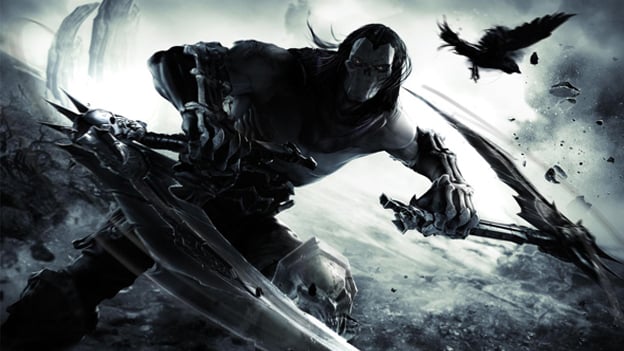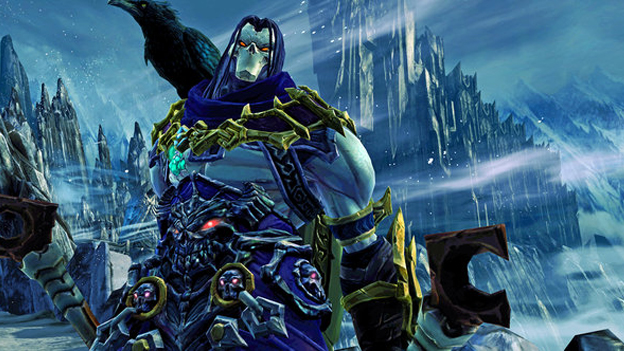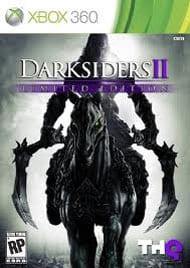The Pale Rider Ponies Up
There is little in the gaming industry that is quite as galling as a game designed by a boardroom. These products of the bottom line come in many forms, from the yearly releases of sports titles and popular first-person shooter franchises (which shall remain nameless) to derivatives of whatever is currently popular, often lacking in features or consisting of multiple successful concepts crammed together in a fashion so haphazard that the seams remain visible.
The original Darksiders initially struck me as such, with what felt like everyone in the world telling me that it was Zelda meets God of War with a little World of Warcraft sprinkled on for aesthetic. This was not wholly true; while Darksiders was an action-adventure game with a fairly liberal dose of brutality, it was neither as over-the-top as God of War nor as exploration-centered as Zelda. And its art? That had less in common with World of Warcraft and more relation to Battle Chasers, a late-90s fantasy comic created and illustrated by Darksiders’ creator, Joe Madureira.

Sometimes, though, it takes a second entry in a series, good though its core may be, before things really hit their stride. It happened with Assassin’s Creed, after all, and, while the Darksiders titles are nowhere near as innovative or intricate as Assassin’s Creed, the second is definitely where the series comes into its own. That it does so by crafting its framework around other titles’ prior successes isn’t an indictment, in this case, but a sign that the developers have done their homework and know what works.
And so we join Death as he rides, striking out on a quest to clear War’s name by restoring that which his brother had destroyed: humanity. This quest will take the player on a journey that spans no less than four primary lands (with a fifth as a sort of environmental cameo). Once a location is unlocked, Death may return there at will to continue his quests, completing sub-quests left unfinished. Yes, there are sub-quests to be had, some with entire dungeons devoted to them (more than one, in some cases) and others that take place on the worlds’ maps, or span multiple dimensions. Through them all, players will engage in combat, puzzle-solving, and platforming—the three-headed chimera of the title’s gameplay.

Combat is much faster than in the original Darksiders, as Death is a more agile combatant. He can’t block by default (though some sub-weapons allow him to shield himself), but is able to nimbly dodge in any direction, out of the way of deadly attacks. Later, this is upgraded so that perfect timing will net one a counter instead of merely an evasion. Death’s dual-scythes turn him into a whirling dervish of damage numbers and lighting effects, while his secondary can either be equally manic or far more deliberate. Either way, the combat system rewards players for mixing it up, allowing even the heaviest weapons to be brought out faster with a lead-in attack from a fast one.
There are combos aplenty (and more, as well as standalone attacks, that one can buy), as well as special abilities that death can earn by leveling up and investing skill points in his two skill trees. These skills are often impressive in scale and their benefits are significant. One’s tactics are further influenced by the gear one wears, which not only determines how much damage one does, but can provide elemental effects (such as freezing an enemy in a block of ice or setting them ablaze) or allow one to absorb some of the damage one does as health. Some weapons are “possessed,” and these can be fed other weapons to enhance their attributes. Some of Death’s gear also comes into play in combat, such as his gun and “Death Grip,” but their primary purview is that of puzzle-solving.

Puzzles in Darksiders II have a somewhat strange progression. Near the beginning of the game, they’re almost dirt easy, with very little to keep track of at any given time. Get over to a switch by using the environment, pull it, blow up some corruption spires with the bombs this unveils and then go on. By the end of the game, though, one is juggling time portals, space portals, and multiple simultaneous Deaths as they navigate serpentine environments, demanding that the player think outside the box in many situations.
There are also a few points in the game during which Death has abilities that he will not retain, which also strongly influence the puzzles for those segments. Generally creative, rarely frustrating, but often thought-provoking, Darksider II’s puzzles are, perhaps, my favorite part of the game, as they demand the most active and constant engagement from the players. The few puzzle-like boss battles that there are meld the pressure of combat with that blessed sense of engagement, and it was cause for me to wish there were more of them.
More often than the combat, though, the puzzle elements of Darksiders II are combined with its platforming or, as the game refers to it, “traversal” mechanics. Death can run along or up walls, scale beams, boost himself off of out-cropping pegs in the walls, slide along conveniently placed hand-grips in the walls, and navigate vein-like vines along both walls and ceilings.
For the most part, this works very well, and even feels markedly satisfying. It’s no Prince of Persia, though, the traversal possessed of an odd sense of deliberate rigidity. This is mostly harmless. It just means the player has to wait for Death to position himself, clearly, to move from one element to the next in the way the player so desires lest he instead end up boosting up the wall over and over before tumbling back down. If he screws this up, it’s usually not a problem. About two-thirds of the way through the game, though, there is a timed traversal segment. The limit is extremely stringent, to the point where even a split second’s indecision can result in the player returning to the beginning of the sequence. The pathway isn’t, itself, confusing, but it’s here where it becomes clear just how much of a weakness it is that Death can’t smoothly transition between traversal states.

Maybe he has trouble making the switch because he’s such a conflicted dude. Whereas War was a veritable automaton, set on his solitary goal and whatever path allowed him to achieve it, Death has made decisions he might regret, and struggles with the implications of what he feels he must do. Whereas War was framed for his alleged crimes and mercilessly punished, Death’s greatest sin is lauded as a heroic accomplishment. It draws an interesting comparison between the two brothers, one of whom is held accountable from without for things he didn’t do while the other is consumed from within by remorse for what everyone tells him was a great service. This internal conflict makes Death a much more relatable character, and flavors his interactions with others, since he is far more given to wit and banter than his beefier brother.
That isn’t to say that the story itself is terrific. It’s there, and it’s compelling enough that I found myself driven to see how it turned out, but the gameplay is the real focus here. The story really only crops up when it feels like it, and, while the core of it makes perfect sense, it has little to do with the hoops Death must jump through to accomplish his task. Characters in this game treat him like a manservant, sending him out on tasks just to prove that he can be sent on other tasks that only bring him marginally closer to his ultimate goal. The first act and the last act, though, do much to flesh out his character and make his path an uncertain one. The middle, though, is mostly superfluous.
So you won’t be coming back for the story, but odds are the game will continue to draw you back. There’s a ton to do, with trinkets and baubles to be found, massive stone body parts to be uncovered, and cavernous depths to be explored in the name of loot and experience.
Is it a perfect game? No, not really, but it is well-crafted with obvious care and attention to detail, netting a smooth and enjoyable experience with just enough addictive qualities in the gameplay to keep one coming back for more.
RATING OUT OF 5 RATING DESCRIPTION 4.2 Graphics
Artistically appealing, extremely expressive, but occasionally marred by muddy textures and slight, but noticeable, slowdown. 4.0 Control
Very easy to grasp, but abilities are somewhat annoying to access (requiring some serious finger gymnastics at times) and traversal feels a bit sluggish and unresponsive. 4.5 Music / Sound FX / Voice Acting
The voices, as befits the dialogue, are bombastic and melodramatic. The music is wonderfully over-the-top, and matches well with the satisfyingly meaty and visceral sounds of combat (and even climbing). It all just sounds solid! 4.7 Play Value
There’s a lot of reason to go back in this one, with a combat arena and sub-quests to be had, as well as countless trinkets to collect. There are also plans for DLC. 4.5 Overall Rating – Must Buy
Not an average. See Rating legend below for a final score breakdown.
| Review Rating Legend | |||
|---|---|---|---|
| 0.1 – 1.9 = Avoid | 2.5 – 2.9 = Average | 3.5 – 3.9 = Good | 4.5 – 4.9 = Must Buy |
| 2.0 – 2.4 = Poor | 3.0 – 3.4 = Fair | 4.0 – 4.4 = Great | 5.0 = The Best |
Game Features:
